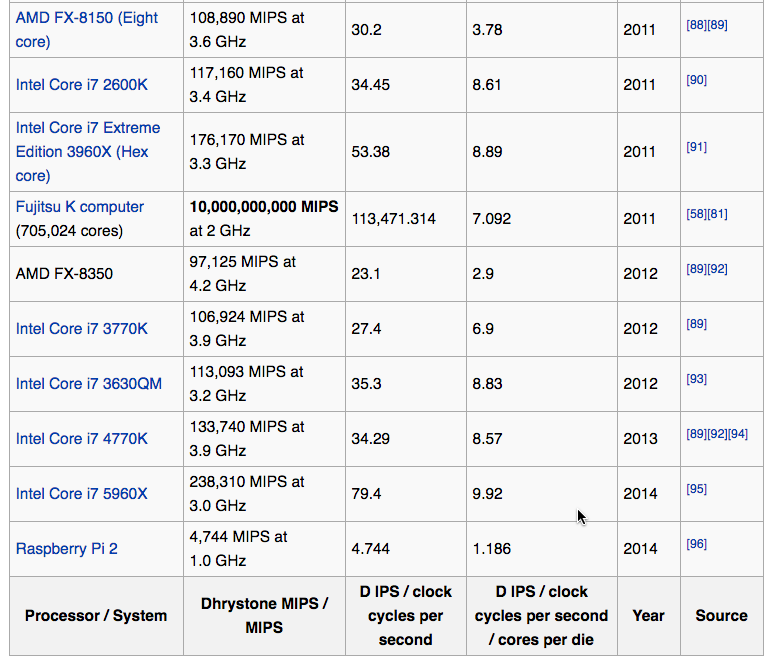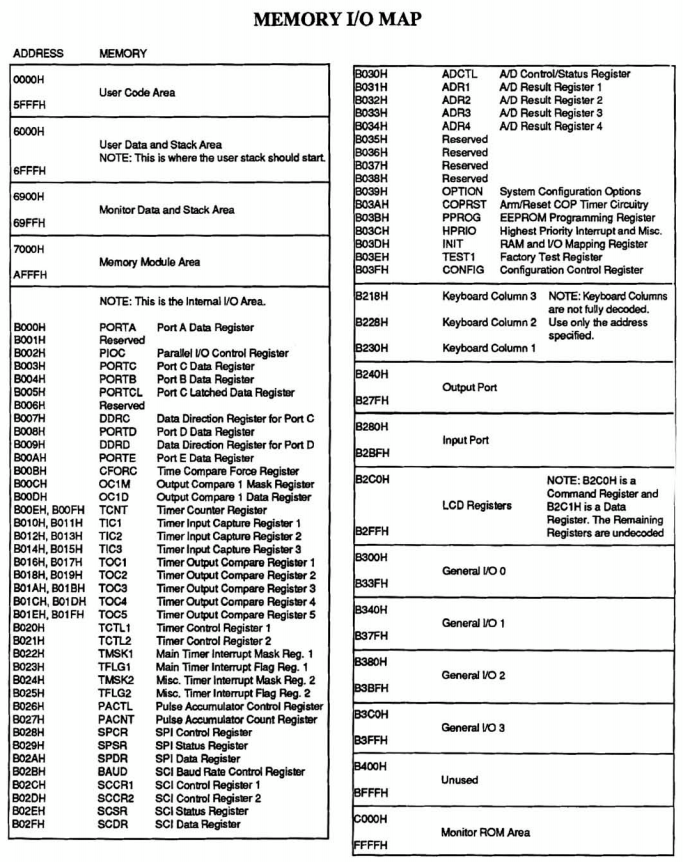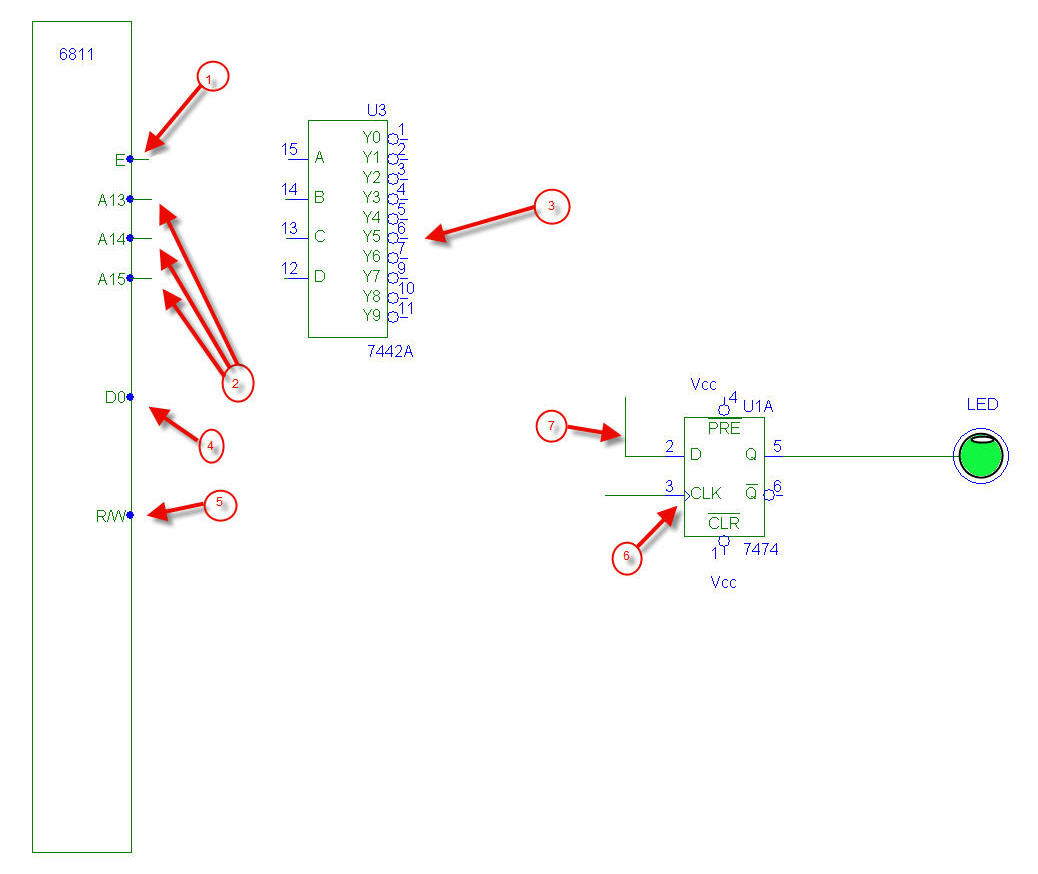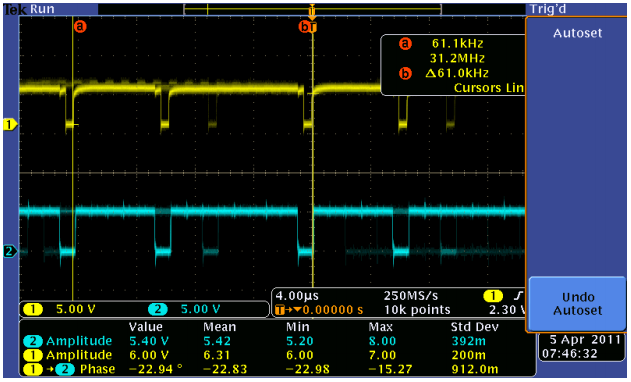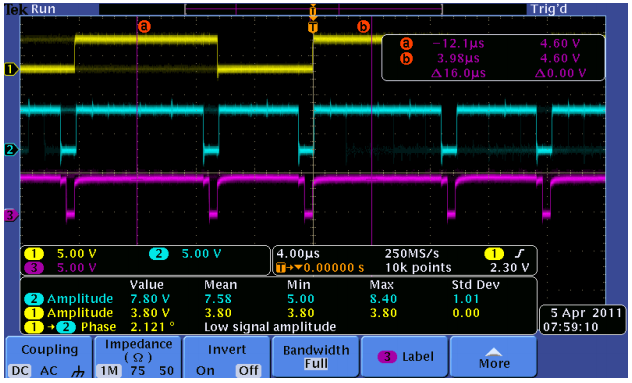Difference between revisions of "CSC270 Lab 8 2016"
(→Part 1: Observing an Endless Loop on the Scope) |
|||
| (14 intermediate revisions by the same user not shown) | |||
| Line 15: | Line 15: | ||
<br /> | <br /> | ||
| − | + | =Part 1: Observing an Endless Loop on the Scope= | |
| − | + | <br /> | |
* Assemble your code by hand | * Assemble your code by hand | ||
* Write down the hexadecimal address and data values in hex. | * Write down the hexadecimal address and data values in hex. | ||
| − | * Write down each address and each byte, one pair per line, and write down the last nybble of each one in binary. See the example below for guidance: | + | * Write down each address and each byte, one pair per line, and write down the last nybble of each one in binary. See the example below for guidance: |
| + | <br /> | ||
| + | <source lang="text"> | ||
addr data addr nybble data nybble | addr data addr nybble data nybble | ||
xxxx xx xxxx xxxx | xxxx xx xxxx xxxx | ||
| − | 000A 1B 1010 1011 | + | 000A 1B 1010 1011 (because A in binary is 1010 and B in binary is 1011) |
xxxx xx xxxx xxxx | xxxx xx xxxx xxxx | ||
xxxx xx xxxx xxxx | xxxx xx xxxx xxxx | ||
| − | + | </source> | |
| + | <br /> | ||
:The reason you want to display the binary information is that you'll have to pick one of the bits of the address or of the data bus to show on the scope, and the bit that has the most ''recognizable'' pattern should be the one you want to pick (i.e. you don't want to pick a bit that would be always 0 or always 1). | :The reason you want to display the binary information is that you'll have to pick one of the bits of the address or of the data bus to show on the scope, and the bit that has the most ''recognizable'' pattern should be the one you want to pick (i.e. you don't want to pick a bit that would be always 0 or always 1). | ||
| Line 34: | Line 37: | ||
* Enter the opcodes in the trainer. | * Enter the opcodes in the trainer. | ||
* Execute the program | * Execute the program | ||
| − | + | <br /> | |
;Question | ;Question | ||
| + | <br /> | ||
: Why is the trainer display blank when the program runs? | : Why is the trainer display blank when the program runs? | ||
| + | <br /> | ||
| − | == | + | ==Observing E and LIR== |
| − | + | <br /> | |
* Put one probe on the '''E''' clock signal (use the handout to spot the different signals on the trainer breadboard area). | * Put one probe on the '''E''' clock signal (use the handout to spot the different signals on the trainer breadboard area). | ||
* Put the other probe on the LIR' signal, which is the complement of the 6811 LIR signal. The 6811 Reference Manual defines the LIR as follows: | * Put the other probe on the LIR' signal, which is the complement of the 6811 LIR signal. The 6811 Reference Manual defines the LIR as follows: | ||
::''LIR': The LIR' (active low) pin goes to an active low during the first E-clock cycle of each instruction and<br/>remains low for the duration of that cycle (opcode fetch). <br />Some MC6811 opcocdes are two consecutive bytes long [...]. For these instruction LIR' goes low for only the first (prebyte) opcode byte fetch. | ::''LIR': The LIR' (active low) pin goes to an active low during the first E-clock cycle of each instruction and<br/>remains low for the duration of that cycle (opcode fetch). <br />Some MC6811 opcocdes are two consecutive bytes long [...]. For these instruction LIR' goes low for only the first (prebyte) opcode byte fetch. | ||
* Take a picture, and be the sleuth! Describe what you are observing. | * Take a picture, and be the sleuth! Describe what you are observing. | ||
| + | <br /> | ||
; Question | ; Question | ||
| + | <br /> | ||
: What is the average number of instructions executed by the 6811 over time. Express your result in MIPS (million instructions per seconds)? | : What is the average number of instructions executed by the 6811 over time. Express your result in MIPS (million instructions per seconds)? | ||
| − | :The table below taken from [http://en.wikipedia.org/wiki/Instructions_per_second Wikipedia's page on Instructions Per Second] shows the | + | :The table below taken from [http://en.wikipedia.org/wiki/Instructions_per_second Wikipedia's page on Instructions Per Second] shows the 2016 entries for various processors and their best performance in MIPS. How does the 6811 compare? |
<br /> | <br /> | ||
[[Image:2011Mips.png|750px]] | [[Image:2011Mips.png|750px]] | ||
| + | <br /> | ||
<br /> | <br /> | ||
| − | == | + | ==Observing R/W'== |
| − | + | <br /> | |
* Connect a third probe to the R/W' (read/write) signal. | * Connect a third probe to the R/W' (read/write) signal. | ||
* Similarly, be the sleuth and explain what you observe. | * Similarly, be the sleuth and explain what you observe. | ||
| + | <br /> | ||
; Question | ; Question | ||
| − | : What is the average number of times your loop runs | + | <br /> |
| + | : What is the average number of times your loop runs in one second? | ||
| + | <br /> | ||
| − | == | + | ==Observing the Address Bus== |
| + | <br /> | ||
* Connect a fourth probe to one of the address bus lines. Pick one that will give you the most information about what is going on. | * Connect a fourth probe to one of the address bus lines. Pick one that will give you the most information about what is going on. | ||
* Similarly, be the sleuth and explain what you observe on the scope. | * Similarly, be the sleuth and explain what you observe on the scope. | ||
| − | + | <br /> | |
| − | == | + | ==Observing the Data Bus== |
| + | <br /> | ||
* Disconnect one of the probes (figure out which signal is least important for this part), and connect it to one of the bits of the data bus. Again, pick the bit that carries most information and will be able to best illustrate what is going on. | * Disconnect one of the probes (figure out which signal is least important for this part), and connect it to one of the bits of the data bus. Again, pick the bit that carries most information and will be able to best illustrate what is going on. | ||
| + | <br /> | ||
;Question | ;Question | ||
| + | <br /> | ||
: You should notice that in one cycle the data bit you picked is not stable, and keeps showing 1 and 0, seemingly simultaneously. Why is this happening? | : You should notice that in one cycle the data bit you picked is not stable, and keeps showing 1 and 0, seemingly simultaneously. Why is this happening? | ||
| Line 71: | Line 86: | ||
<br /> | <br /> | ||
<br /> | <br /> | ||
| − | = | + | |
| − | + | =Part 2= | |
| − | <center> | + | <br /> |
| − | [[Image: | + | ==Timing Diagram== |
| − | </ | + | |
| + | Everything you are doing today is an important step in logic design. Logic design requires organizing digital electronic in a way that follows rules for proper behavior of the system over time. This is a form of engineering. The timing below illustrates how logic designers indicate the properties of various signals and their relationship to each other. We have simplified these rules tremendously in this lab by stating these simple rules: | ||
| + | * An I/O operation must happen within one cycle | ||
| + | * Signals coming out of the processor cannot be trusted during the first half of a cycle | ||
| + | * The E clock is the one that fully defines a cycle. | ||
| + | * Signas remain stables for a short period of time after the E signal goes from low to high, at the end of a cycle. | ||
| + | |||
| + | <br /> | ||
| + | <br /> | ||
| + | <center>[[Image:CSC270 FigureA14.png|400px]]</center> | ||
| + | <br /> | ||
| + | |||
| + | |||
| + | ==I/O Address== | ||
| + | First you need to find a range of addresses that are not used for RAM, ROM or I/O devices by the 6811 in the Heathkit. Observe the map below showing the memory address map for the kit and pick one address that will not energize memory or already-built I/O devices. | ||
| + | <br /> | ||
| + | <br /> | ||
| + | [[Image:6811KitMemoryMap.png|600px|center]] | ||
| + | <br /> | ||
| + | |||
| + | <br /> | ||
| + | ==Setup== | ||
| + | The figure below contains all the main players for today's lab. | ||
| + | |||
| + | [[Image:CSC270_6811_output_led_incomplete.jpg|730 px]] | ||
| + | <br> | ||
| + | |||
| + | You have to figure out the missing areas, with a little bit of help: | ||
| + | |||
| + | * 1. '''E'''. The clock. You are going to use it to make the decoder operate only during the second half of a processor cycle, when all the signals are stable. E is low in the first half of the cycle, and is high in the second half. | ||
| + | |||
| + | :A decoder used as "logic glue" is a good way to connect a processor to devices such as memory or I/O devices. One problem, though, is that the [http://cs.smith.edu/~thiebaut/classes/270/datasheets/sn74ls42rev5.pdf 7442 decoder] that we have available to us is a 4-to-10 decoder that does not have an Enable input... We'll have to work with that... | ||
| + | |||
| + | * 2. '''The Address bits A15, A14, A13'''. Somehow we should connect them along with E to the decoder so that we can recognize an address in the range 7000 to AFFF (which we should have discovered in the first part of this lab to be available to us, since we don't have a memory cartridge installed in the kit). | ||
| + | |||
| + | :In class we have used a 3-to-8 decoder with active low enable. Unfortunately we do not have one to play with. Instead we have a 4-to-10 decoder with no enable... Can you figure out how to make a 3-to-8 decoder with active low enable out of a 4-to-10 without enable? | ||
| + | |||
| + | :Figure out a way to connect E, A15, A14, and A13 to the decoder inputs so that one of the Yi outputs is activated for an address that you will have selected in the range 7000 to AFFF, and only in the second half of the E cycle. Make sure that the Y output you selected is not activated by any address lower than 7000, or by an address higher than AFFF. | ||
| + | |||
| + | <br /> | ||
| + | <source lang="text"> | ||
| + | |||
| + | address Yi activated by this address | ||
| + | ________ _____________________________ | ||
| + | |||
| + | 6000 (RAM) Y_ | ||
| + | |||
| + | 7000 (avail) Y_ | ||
| + | |||
| + | 8000 (avail) Y_ | ||
| + | |||
| + | 9000 (avail) Y_ | ||
| + | |||
| + | A000 (µP IO) Y_ | ||
| + | |||
| + | </source> | ||
| + | <br /> | ||
| + | |||
| + | * 3. There isn't one unique answer for the''' selection of Yi''' output. Depending on how you connect the A15, A14, A13 and E signals to the decoder, you may end up with a Yi that is not the same as the Yi another team will have selected during this lab. You now need to use the Yi active-low output that you have selected and see how it should be connected to the clock input of the D-flipflop. | ||
| + | |||
| + | :Complete the timing diagram below showing the shape of the different signals when the processor is writing at the address you selected as the address of your I/O device. | ||
| + | |||
| + | |||
| + | <br /><center>[[Image:6811TimingDiagramIOOutput.png|600px]]</center><br /> | ||
| + | |||
| + | |||
| + | |||
| + | * 4. This step should be straightforward. Connect the D0 output of the data bus to the data input of your flipflop... | ||
| + | |||
| + | |||
| + | * 5. This step should have been taken care of in Step 4 above. Make sure you get me to verify your schematics before you start wiring things up. | ||
| + | |||
| + | ==Testing your circuit== | ||
| + | |||
| + | [[Image:CSC270_6811_IO3.png|400px|right]] | ||
| + | Wire up your circuit. Make sure you put the 7442 in the leftmost section of the breadboard, as you will be reusing it in the next lab(s). For this reason make sure you keep the 7442 wired up on the breadboad at the end of today's lab, so you won't have to rewire it next time when we wire up an input port. | ||
| + | |||
| + | Write a simple endless loop that repeatedly write 0, then 1, then 0, then 1, etc., to your 1-bit flipflop. Assemble it, enter it in the kit, and run it. | ||
| + | |||
| + | Use the scope and take a look at R/W and your Yi output. | ||
| + | |||
| + | Verify that you see something like the picture on the right, taken by Tiffany Liu: | ||
| + | |||
| + | |||
| + | In your report, explain which signal is which, and why this timing diagram is the correct one. Make sure the scale is clear, especially the time scale. In particular, indicate where your endless loop starts and ends, and how long it lasts. Relate that to the number of cycles your endless loop is supposed to take. | ||
| + | |||
| + | [[IMage:CSC270_6811_IO2.png| 400px|right]] | ||
| + | Now add a scope probe to the Q output of the flipflop. This is the bit that you are storing in the 1-bit I/O Port which your flipflop implements. | ||
| + | |||
| + | Verify that you see something like the one on the right, taken by Tiffany Liu. | ||
| + | |||
| + | In your report, explain which signal is which, and why this timing diagram is the correct one. | ||
| + | |||
| + | <br /> | ||
| + | |||
| + | <br /> | ||
| + | |||
| + | <br /> | ||
| + | |||
<br /> | <br /> | ||
| + | |||
<br /> | <br /> | ||
| + | |||
<br /> | <br /> | ||
| + | |||
<br /> | <br /> | ||
| + | |||
| + | ==A software driver== | ||
| + | |||
| + | A simple way to write a driver is to create two functions that can be called to set the LED ON, or to turn it OFF. | ||
| + | |||
| + | We can call the first function ''turnLEDOn'', and the second one ''turnLEDOff''. | ||
| + | |||
| + | Here is a way to organize your endless loop using these functions: | ||
| + | |||
| + | <br /> | ||
| + | <source lang="text"> | ||
| + | LED EQU ???? ; enter the address energizing your Yi output | ||
| + | |||
| + | ORG 0000 | ||
| + | loop: jsr turnLEDOn | ||
| + | jsr turnLEDOff | ||
| + | jmp loop | ||
| + | |||
| + | ORG 0010 | ||
| + | turnLEDOn: ldaa #1 | ||
| + | staa LED | ||
| + | rts | ||
| + | |||
| + | turnLEDOff:ldaa #0 | ||
| + | staa LED | ||
| + | rts | ||
| + | </source> | ||
| + | <br /> | ||
| + | |||
| + | The '''JSR''' and '''RTS''' instructions are new. The JSR instruction '''J'''umps to a '''S'''ub'''R'''outine which is another name for function. It is like a jump except the processor also saves in the stack the address it must return to in the main program when it encounters the RTS instruction. RTS means '''R'''re'''T'''urn from '''S'''ubroutine, and it will pop off the stack the return address and put it in the Program Counter. | ||
| + | |||
| + | Assemble the above program by hand, and verify that you get a similar waveform as the last one you got before, where the time scale may have changed (why?). | ||
| + | |||
| + | ==Slowing down the loop== | ||
| + | The table below is familiar by now. You saw it in a recent homework assignment. It shows entry points in the ''Monitor'' (that's the name of the tiny operating system of the kit) for doing different things, like reading characters, displaying strings, etc. One of them is the entry point for a wait subroutine that is a delay of 1 second. When you jump to this address with a JSR instruction, you will return to your program only after a 1 second delay. | ||
| + | |||
| + | ::''Note: Be careful about the JSR Delay call: it will not maintain the value that is in '''Acca''' when you call it. So if you expect Acca to have the same value when you return from the Delay subroutine, put it in a variable before the call, and get it back from the variable after the call. You can also push it in the stack and pop it from the stack before and after the call; that will work too!'' | ||
| + | |||
| + | Add calls to the delay subroutine in your loop so that we can see your LED stay ON for a second, then turn OFF for a second, and so on. | ||
| + | |||
| + | <br /> | ||
| + | <center>[[Image:CSC270_6811_MonitorEntryPoints.png|500px]]</center> | ||
| + | <br /> | ||
| + | |||
| + | ==Questions== | ||
| + | |||
| + | Include the answer to these questions in your report | ||
| + | |||
| + | * '''Question 1''': What is the frequency at which your LED blink (without the delay routine)? | ||
| + | |||
| + | * '''Question 2''': What is the fastest frequency at which you can make the LED blink? Please answer with a theoretical answer, which includes the frequency of E, and what you know of 6811 instructions, and how you can arrange them to allow for the fastest possible way to switch the LED On and Off repeatedly. | ||
| + | |||
| + | * '''Question 3''': Once you stored a bit in the flip-flop, can you read it back from your program. In other words, assume you want your program to discover what the value of the output Q of the flipflop is, can your program do it, and if so, how? | ||
| + | |||
| + | * '''Question 4''': Can you use the keyboard to store 1 or 0 in your 1-bit port? Try it. What do you observe? | ||
| + | |||
| + | =Schematics= | ||
| + | |||
| + | You may use the figure below to create your full design. | ||
| + | |||
| + | [[Image:CSC270_6811_output_LED_incomplete2.jpg | 730px]] | ||
| + | |||
<br /> | <br /> | ||
[[Category:CSC270]][[Category:Labs]][[Category:6811]] | [[Category:CSC270]][[Category:Labs]][[Category:6811]] | ||
Latest revision as of 13:14, 31 March 2016
--D. Thiebaut (talk) 11:29, 22 March 2016 (EDT)
|
The goal for this lab is to take the endless loop program you wrote at the end of last lab, assemble it and enter its code in the 6811 trainer, and use the scope to see its execution, live! |
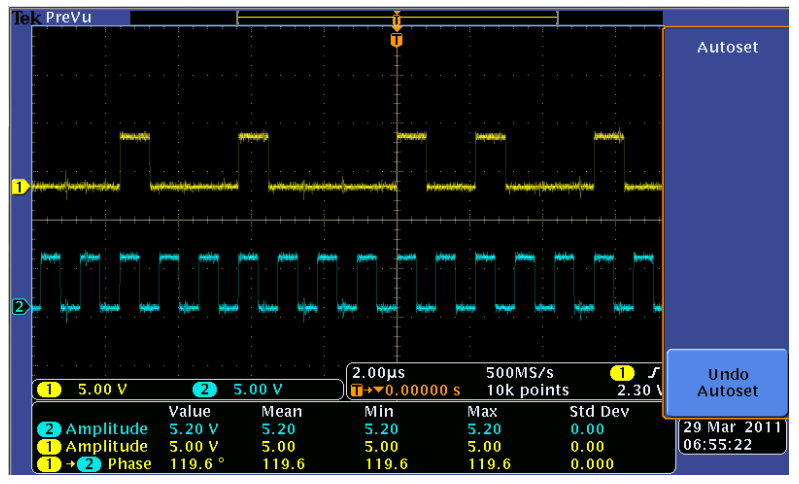
(Picture taken by Tiffany Liu, 2011)
Part 1: Observing an Endless Loop on the Scope
- Assemble your code by hand
- Write down the hexadecimal address and data values in hex.
- Write down each address and each byte, one pair per line, and write down the last nybble of each one in binary. See the example below for guidance:
addr data addr nybble data nybble
xxxx xx xxxx xxxx
000A 1B 1010 1011 (because A in binary is 1010 and B in binary is 1011)
xxxx xx xxxx xxxx
xxxx xx xxxx xxxx
- The reason you want to display the binary information is that you'll have to pick one of the bits of the address or of the data bus to show on the scope, and the bit that has the most recognizable pattern should be the one you want to pick (i.e. you don't want to pick a bit that would be always 0 or always 1).
- Create a cycle by cycle description of the execution of the instruction. Use one line per cycle, and use text, rather than a drawing.
- Enter the opcodes in the trainer.
- Execute the program
- Question
- Why is the trainer display blank when the program runs?
Observing E and LIR
- Put one probe on the E clock signal (use the handout to spot the different signals on the trainer breadboard area).
- Put the other probe on the LIR' signal, which is the complement of the 6811 LIR signal. The 6811 Reference Manual defines the LIR as follows:
- LIR': The LIR' (active low) pin goes to an active low during the first E-clock cycle of each instruction and
remains low for the duration of that cycle (opcode fetch).
Some MC6811 opcocdes are two consecutive bytes long [...]. For these instruction LIR' goes low for only the first (prebyte) opcode byte fetch.
- LIR': The LIR' (active low) pin goes to an active low during the first E-clock cycle of each instruction and
- Take a picture, and be the sleuth! Describe what you are observing.
- Question
- What is the average number of instructions executed by the 6811 over time. Express your result in MIPS (million instructions per seconds)?
- The table below taken from Wikipedia's page on Instructions Per Second shows the 2016 entries for various processors and their best performance in MIPS. How does the 6811 compare?
Observing R/W'
- Connect a third probe to the R/W' (read/write) signal.
- Similarly, be the sleuth and explain what you observe.
- Question
- What is the average number of times your loop runs in one second?
Observing the Address Bus
- Connect a fourth probe to one of the address bus lines. Pick one that will give you the most information about what is going on.
- Similarly, be the sleuth and explain what you observe on the scope.
Observing the Data Bus
- Disconnect one of the probes (figure out which signal is least important for this part), and connect it to one of the bits of the data bus. Again, pick the bit that carries most information and will be able to best illustrate what is going on.
- Question
- You should notice that in one cycle the data bit you picked is not stable, and keeps showing 1 and 0, seemingly simultaneously. Why is this happening?
Part 2
Timing Diagram
Everything you are doing today is an important step in logic design. Logic design requires organizing digital electronic in a way that follows rules for proper behavior of the system over time. This is a form of engineering. The timing below illustrates how logic designers indicate the properties of various signals and their relationship to each other. We have simplified these rules tremendously in this lab by stating these simple rules:
- An I/O operation must happen within one cycle
- Signals coming out of the processor cannot be trusted during the first half of a cycle
- The E clock is the one that fully defines a cycle.
- Signas remain stables for a short period of time after the E signal goes from low to high, at the end of a cycle.
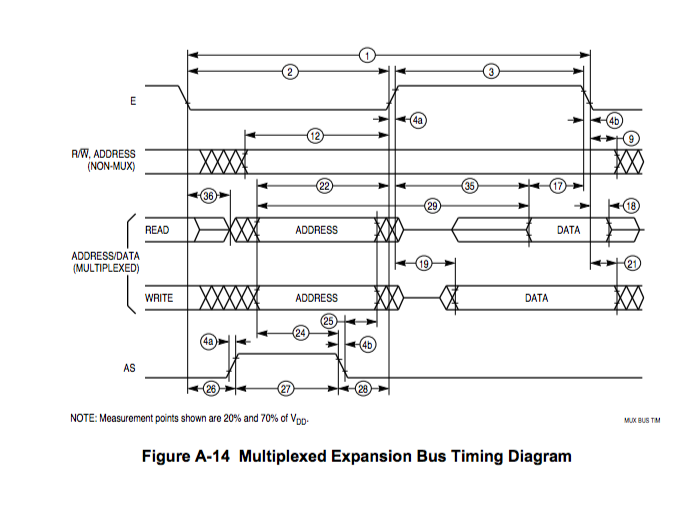
I/O Address
First you need to find a range of addresses that are not used for RAM, ROM or I/O devices by the 6811 in the Heathkit. Observe the map below showing the memory address map for the kit and pick one address that will not energize memory or already-built I/O devices.
Setup
The figure below contains all the main players for today's lab.
You have to figure out the missing areas, with a little bit of help:
- 1. E. The clock. You are going to use it to make the decoder operate only during the second half of a processor cycle, when all the signals are stable. E is low in the first half of the cycle, and is high in the second half.
- A decoder used as "logic glue" is a good way to connect a processor to devices such as memory or I/O devices. One problem, though, is that the 7442 decoder that we have available to us is a 4-to-10 decoder that does not have an Enable input... We'll have to work with that...
- 2. The Address bits A15, A14, A13. Somehow we should connect them along with E to the decoder so that we can recognize an address in the range 7000 to AFFF (which we should have discovered in the first part of this lab to be available to us, since we don't have a memory cartridge installed in the kit).
- In class we have used a 3-to-8 decoder with active low enable. Unfortunately we do not have one to play with. Instead we have a 4-to-10 decoder with no enable... Can you figure out how to make a 3-to-8 decoder with active low enable out of a 4-to-10 without enable?
- Figure out a way to connect E, A15, A14, and A13 to the decoder inputs so that one of the Yi outputs is activated for an address that you will have selected in the range 7000 to AFFF, and only in the second half of the E cycle. Make sure that the Y output you selected is not activated by any address lower than 7000, or by an address higher than AFFF.
address Yi activated by this address
________ _____________________________
6000 (RAM) Y_
7000 (avail) Y_
8000 (avail) Y_
9000 (avail) Y_
A000 (µP IO) Y_
- 3. There isn't one unique answer for the selection of Yi output. Depending on how you connect the A15, A14, A13 and E signals to the decoder, you may end up with a Yi that is not the same as the Yi another team will have selected during this lab. You now need to use the Yi active-low output that you have selected and see how it should be connected to the clock input of the D-flipflop.
- Complete the timing diagram below showing the shape of the different signals when the processor is writing at the address you selected as the address of your I/O device.
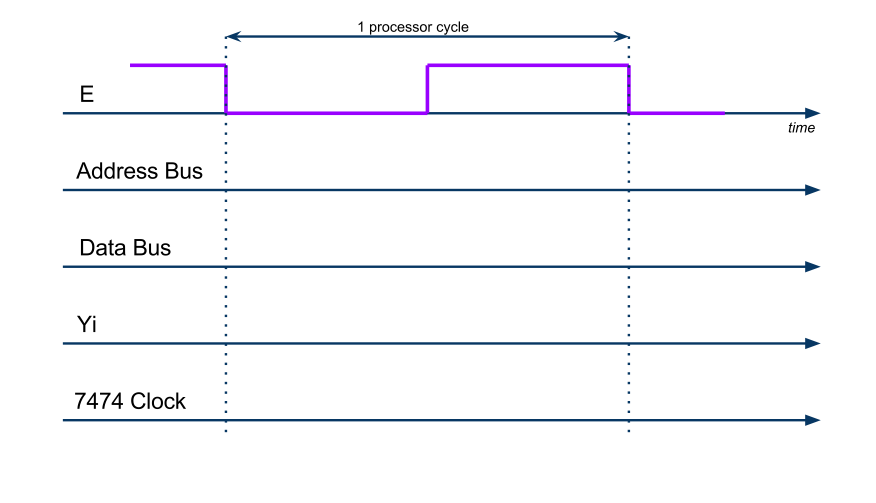
- 4. This step should be straightforward. Connect the D0 output of the data bus to the data input of your flipflop...
- 5. This step should have been taken care of in Step 4 above. Make sure you get me to verify your schematics before you start wiring things up.
Testing your circuit
Wire up your circuit. Make sure you put the 7442 in the leftmost section of the breadboard, as you will be reusing it in the next lab(s). For this reason make sure you keep the 7442 wired up on the breadboad at the end of today's lab, so you won't have to rewire it next time when we wire up an input port.
Write a simple endless loop that repeatedly write 0, then 1, then 0, then 1, etc., to your 1-bit flipflop. Assemble it, enter it in the kit, and run it.
Use the scope and take a look at R/W and your Yi output.
Verify that you see something like the picture on the right, taken by Tiffany Liu:
In your report, explain which signal is which, and why this timing diagram is the correct one. Make sure the scale is clear, especially the time scale. In particular, indicate where your endless loop starts and ends, and how long it lasts. Relate that to the number of cycles your endless loop is supposed to take.
Now add a scope probe to the Q output of the flipflop. This is the bit that you are storing in the 1-bit I/O Port which your flipflop implements.
Verify that you see something like the one on the right, taken by Tiffany Liu.
In your report, explain which signal is which, and why this timing diagram is the correct one.
A software driver
A simple way to write a driver is to create two functions that can be called to set the LED ON, or to turn it OFF.
We can call the first function turnLEDOn, and the second one turnLEDOff.
Here is a way to organize your endless loop using these functions:
LED EQU ???? ; enter the address energizing your Yi output
ORG 0000
loop: jsr turnLEDOn
jsr turnLEDOff
jmp loop
ORG 0010
turnLEDOn: ldaa #1
staa LED
rts
turnLEDOff:ldaa #0
staa LED
rts
The JSR and RTS instructions are new. The JSR instruction Jumps to a SubRoutine which is another name for function. It is like a jump except the processor also saves in the stack the address it must return to in the main program when it encounters the RTS instruction. RTS means RreTurn from Subroutine, and it will pop off the stack the return address and put it in the Program Counter.
Assemble the above program by hand, and verify that you get a similar waveform as the last one you got before, where the time scale may have changed (why?).
Slowing down the loop
The table below is familiar by now. You saw it in a recent homework assignment. It shows entry points in the Monitor (that's the name of the tiny operating system of the kit) for doing different things, like reading characters, displaying strings, etc. One of them is the entry point for a wait subroutine that is a delay of 1 second. When you jump to this address with a JSR instruction, you will return to your program only after a 1 second delay.
- Note: Be careful about the JSR Delay call: it will not maintain the value that is in Acca when you call it. So if you expect Acca to have the same value when you return from the Delay subroutine, put it in a variable before the call, and get it back from the variable after the call. You can also push it in the stack and pop it from the stack before and after the call; that will work too!
Add calls to the delay subroutine in your loop so that we can see your LED stay ON for a second, then turn OFF for a second, and so on.
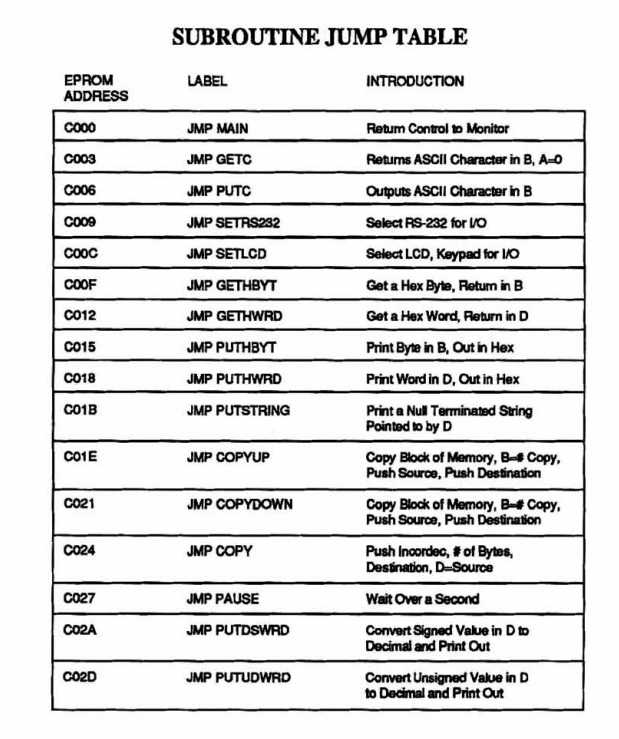
Questions
Include the answer to these questions in your report
- Question 1: What is the frequency at which your LED blink (without the delay routine)?
- Question 2: What is the fastest frequency at which you can make the LED blink? Please answer with a theoretical answer, which includes the frequency of E, and what you know of 6811 instructions, and how you can arrange them to allow for the fastest possible way to switch the LED On and Off repeatedly.
- Question 3: Once you stored a bit in the flip-flop, can you read it back from your program. In other words, assume you want your program to discover what the value of the output Q of the flipflop is, can your program do it, and if so, how?
- Question 4: Can you use the keyboard to store 1 or 0 in your 1-bit port? Try it. What do you observe?
Schematics
You may use the figure below to create your full design.
